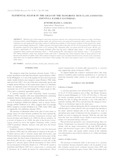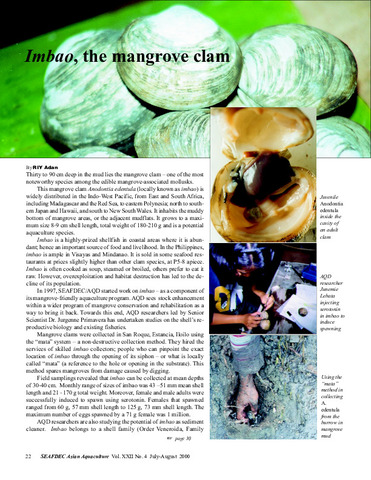Gill structure, anatomy and habitat of Anodontia edentula: Evidence of endosymbiosis
- Global styles
- MLA
- Vancouver
- Elsevier - Harvard
- APA
- Help

View/
Date
2001Page views
4,169ASFA keyword
AGROVOC keyword
Taxonomic term
Metadata
Show full item record
Share
Abstract
Surveys and interviews were conducted to determine sources and habitat of Anodontia edentula. Results showed that they inhabit muddy substrate of mangrove areas or the adjacent mudflats, burying at 20-60 cm deep in the mud. They are strategically situated in the sulfide-rich, low-oxygen layer of the substrate but have access to oxygen through their inhalant tube; both sulfide and oxygen are essential for their survival. Study of the clam s gross anatomy revealed thick, fleshy, deep purple to blackish brown gills; reduced digestive structure; and a highly elastic foot capable of extending several times longer than its body length. These observations conform with the anatomy of fellow lucinid clams. Furthermore, scanning electron micrographs showed coccoid or spherical bacteria occupying bacteriocytes in the clam s gills. Intermediate cells separating bacteriocytes observed in other lucinids were also noted in the SEM.
Suggested Citation
Lebata, M. J. H. L., & Primavera, J. (2001). Gill structure, anatomy and habitat of Anodontia edentula: Evidence of endosymbiosis. Journal of Shellfish Research , 20(3), 1273-1278. http://hdl.handle.net/10862/1855
Type
ArticleISSN
0730-8000Collections
- Journal Articles [1256]
Related items
Showing items related by title, author, creator and subject.
-
Elemental sulfur in the gills of the mangrove mud clam Anodontia edentula (Family Lucinidae)
Different sizes of the mangrove mud clam Anodontia edentula were collected from the mangroves in Brgy. San Roque in Estancia, Iloilo, central Philippines, and the mantle, gill, and foot tissues were analyzed for ... -
Oxygen, sulphide and nutrient uptake of the mangrove mud clam Anodontia edentula (Family: Lucinidae)
Oxygen, sulphide and nutrient (ammonia, nitrite and phosphate) uptake of Anodontia edentula was measured. Oxygen and sulphide were measured from sealed containers provided with 1 l fresh mangrove mud (sulphide source) and ... -
Imbao, the mangrove clam
Adan, R. I. Y. (Aquaculture Department, Southeast Asian Fisheries Development Center, 2000)






